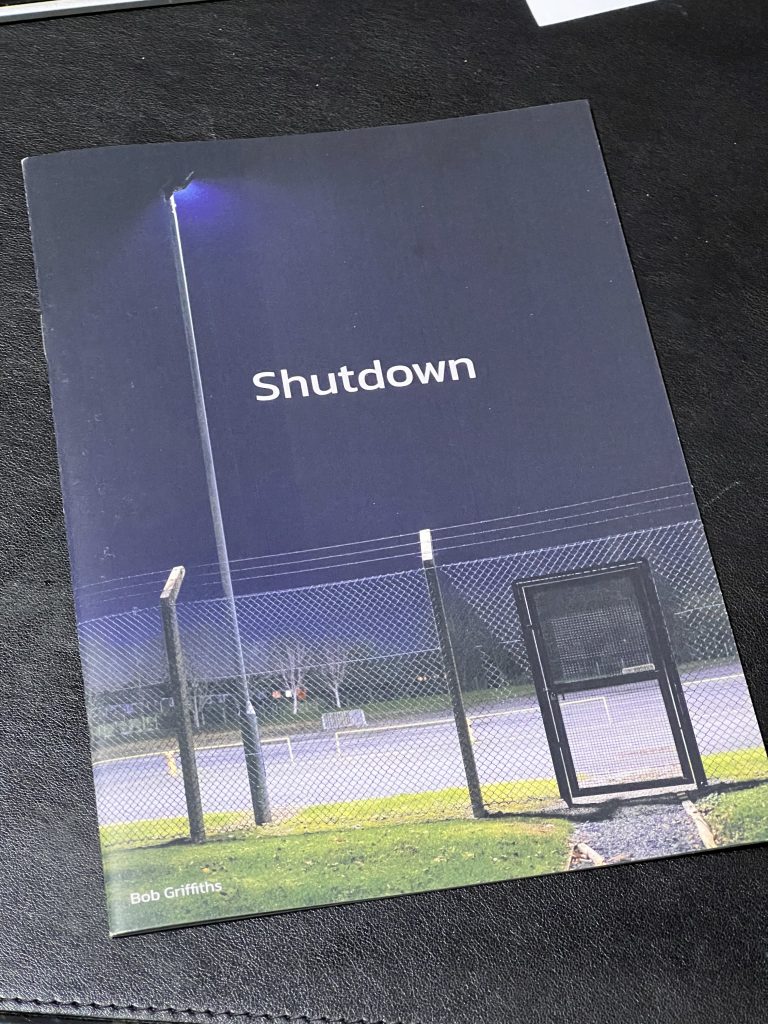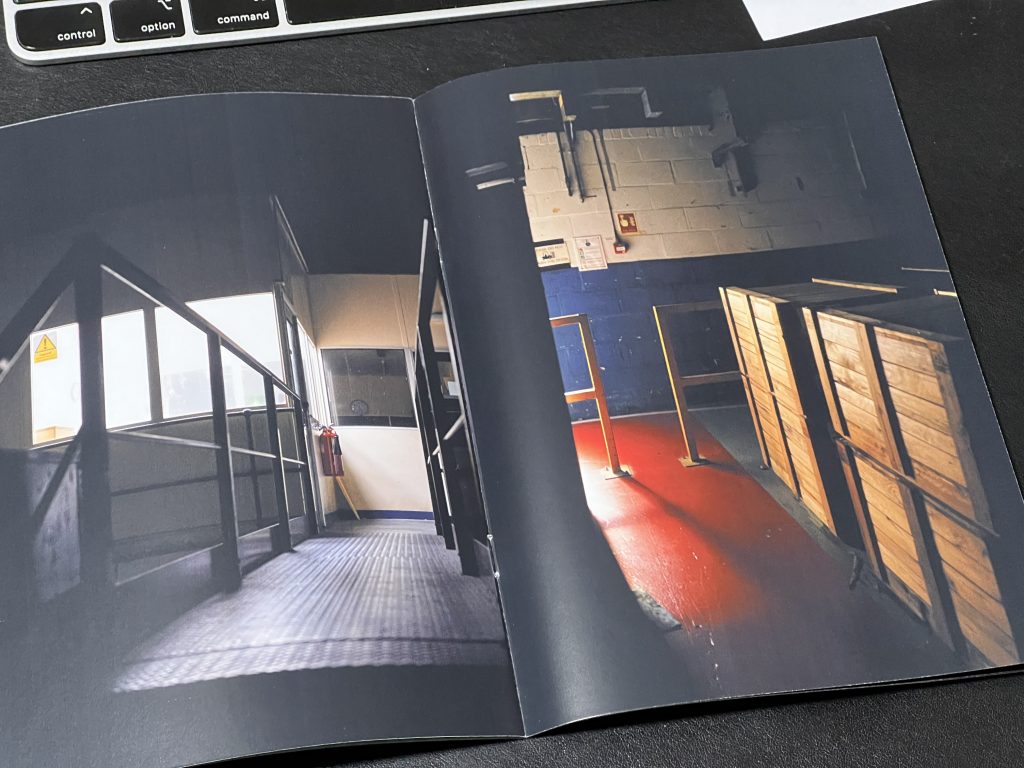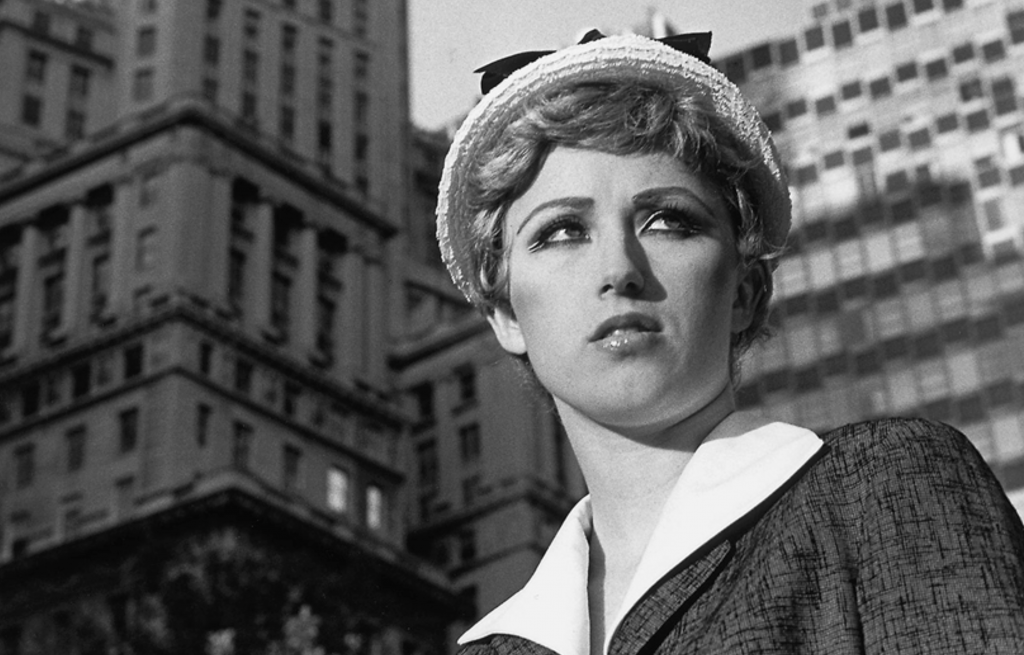This week we had a planned tutorial with Sylvia and then this was followed by a lecture on Postmodernism.
Practice Tutorial
The tutorial was a mixture of Practice and Contextual so we began by discussing the practice part of the module. I explained that I’d got my prints back from the printers on acrylic and trial fitted them onto the pallet which I plan to lean against the wall of the gallery. We discussed that I had thought of mounting them in another way, with the three triangular pallets as per this post. We also discussed different printing strategies depending on where in the rooms they might be mounted and I mentioned about the use of LED lighting behind the pallet for some context as the images are about light entering the buildings and how it alters perception of the building in use throughout the day.
We talked about the way in which I would safely mount it to the wall too, ensuring that it doesn’t fall and injure anyone. This is an important point and one that Naomi Greaves talked about in the artists talk a few weeks ago.

I also shared with Sylvia, a copy of my new zine, Shutdown. This is a small zine of images that contain the three images I’m exhibiting as well as the other shortlisted images from my three shoots around the factory buildings. My plan is to have a few of these with my work so the text in the rear might provide some further context, if needed. These would be for sale, possibly at £1 each to simply cover the costs of getting them printed. If I sell them online like my Car Park zine then the prices would need to go up a little.


Contextual Tutorial
Moving into the Contextual part of the tutorial I discussed with Sylvia, the essay that I had started writing. My essay is really a visual analysis of two pieces of work, photographs, by Mark Power and Liam Wong. The essay is up to around 3500 words long and doesn’t yet have a conclusion. It needs to be 2500 words long when it is finished and edited.
I talked about the question that it is driven by, “Can a photograph evoke an atmosphere consistently?” and whether I needed to finish up with a definitive answer to this question as I feel this might be troublesome.
Sylvia said it could be wise to open up the definition and remove the word “Consistently” as a start to allow me to simply discuss whether people feel atmospheres from photos. The word consistently, thinking about it now, sounds like I would need ot do scientific experiments with people sat in boxes pressing a mood button when a photo came on screen. This work isn’t as in depth as that so I think we can lose that word.
The word “can” at the start could also be replaced with another word that allows some freedom in the exploration of the topic/theme of the visual analysis.
I mentioned briefly also that I would be carrying out a short survey on MS Forms with friends, family and colleagues to feedback on words that they find spring to mind from looking at Wong and Power’s photographs. This might be a bit wooly but it would be good to get some words that back up the first paragraph of the essay in which I’ve selected a a few words but cannot find a list elsewhere.
When talking about Power’s photo, Sylvia asked me whether there was much info about the photograph and I explained that I had emailed and DM’d on Instagram to Mark Power but hadn’t yet had a response. She said that it didn’t really matter and it could be related to other works that feature this sort of look, one such work was a piece called “Can’t Help Myself” by Sun Yuan & Peng Yu. It features a large industrial robot, seemingly sweeping a pool of blood around itself, trying to keep it under control. I have seen a video of this work before but when Sylvia showed me , I instantly saw the link between the blood like fluid seeping across a floor.
In the afternoon we discussed Postmodernism in a seminar in the lecture theatre. Sylvia was being observed in this lesson so we were on our best behaviour, just kidding, we’re always on our best behaviour.
What is Postmodernism?
Postmodernism is particularly difficult to define and Sylvia shared a quote by Andrew Logan on the topic.
“Postmodernism – yes, I still really don’t understand what post modernism is. I’ve been told many times and it’s been explained to me many times and I still am bewildered. But perhaps that’s part of the movement – bewilderment,”
Andrew Logan
The word Post means “after” so it simply means “after modernism”
Modernism is generally thought of as being around the late 19th and early 20th century.
Postmodern came about from the 1960s and onwards
Modernism:
- Black and white thinking
- Objectivity
- Reasoning
- Rationality
Postmodernists argue that humans and human societies are complex, fluid and dynamic where modernists had a more black and white categories than a spectrum.
Modernism to postmodernism was shifting because society started being viewed differently, the summer of love and hippy movements, pop art, and a general freedom of expression was growing across the world.
Previous world wars and colonialism caused people to question their own place in universe.
A traumatic time such as the war icould be thought to be similar to the Covid pandemic and post pandemic periods that we’ve lived through recently. Sylvia mentioned the changes in working practices as people used to work from home rarely before the pandemic and now it’s a challenge to get people to work in an office.
What happened when the world started moving away from modernism?
- Release of constraints of modern era, complexity, ambiguity,celebration of human diversity,abstraction,fragmentation,nonlinear narratives
- Postmodernism simultaneously resists a distinct definition, it is against categorisation so how can we correctly categorise the movement? It is a paradox of sorts.
- Modernism has a master narrative and postmodernism has nonlinear narratives. Master narratives represent a world view and the norms associated with the society that the people are a member of.
- Postmodernism was discussed by Derrida and Lyotard both philosophers who have written ont he subject, but the writings are incredibly heavy and very difficult to access as a newbie.
- Baudrillard is critical of postmodern culture
- Postmodernism is a disintegration of boundaries
- Working class vs middle class were fixed and defined but in the postmodern era are more fluid.
- this blurring of boundaries can be troublesome for people who may need to be categorised for a social movement etc.
Artists known for Postmodernism
We looked at some other works by postmodern artists such as:
- Judith Butler is important in the postmodern feminist theory space and very influential.
- Joseph Kosuth. Clock (one and five)
- Cindy Sherman. Untitled Film Stills
- Jean-Michel Basquiat
- Damien Hirst. Away from the flock
- Kenneth Josephson
- Jeff Wall

Conclusion
For me, this lesson was very valuable and it helped me to understand the concept of postmodernism. Before this lecture I struggled to understand what art could be considered as postmodernism but I think that I have a better grasp of what might fall into the category. Things such as pop art, images that move away from the formal and compliant images from earlier in the 20th century are easier to spot now.
We were told that Postmodernism doesn’t have a proper set of categorisations as it’s bucking the trend of the conventions from Modernism and as such it’s very difficult to put your finger on a piece for certain. This is not to say that other artists in the more distant past may have played around with concepts better linked to Postmodernism but it would not have been called that at the time.
I asked Sylvia that if postmodernism replaced modernism, what will /has replace postmodernism? She explained that all art is now postmodern as there are fewer categorisations and that if Hirst can get a Shark in formaldehyde into a museum then there might not be anything that can’t be displayed an a museum.
I did a google search for what replaces postmodernism and the only real answer I got was the word Metamodernism. This effectively means the same as postmodernism as “meta” and “post” both mean “after” but the word Meta has a really 21st century feeling with the word being used all over the web, in web page programming and new phrases. I wonder if this will stick and become the new thing. It’s actually described as a movement that oscillates between modernism and postmodernism.
It’s when you start finding out things like this such as images can be in many different categories, it makes me wonder whether it’s difficult to actually produce work that fits into any one category. It’s almost as though people look back at all of the work for the period and then retrospectively name it. such as backronyms where you choose the the acronym and then make up the words off the acronym.
Be First to Comment